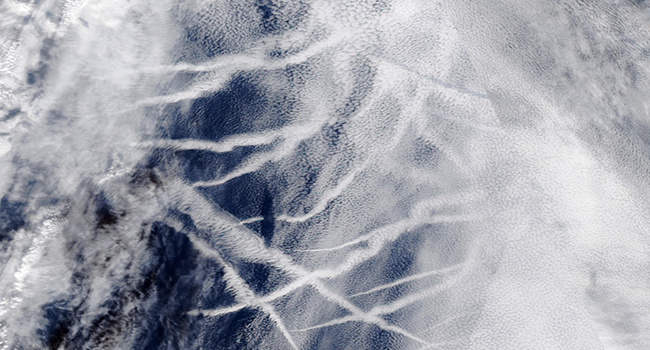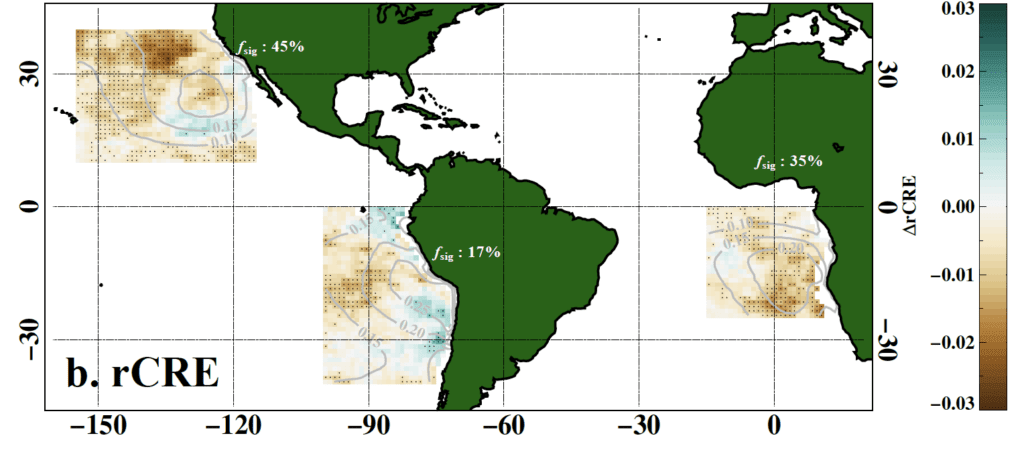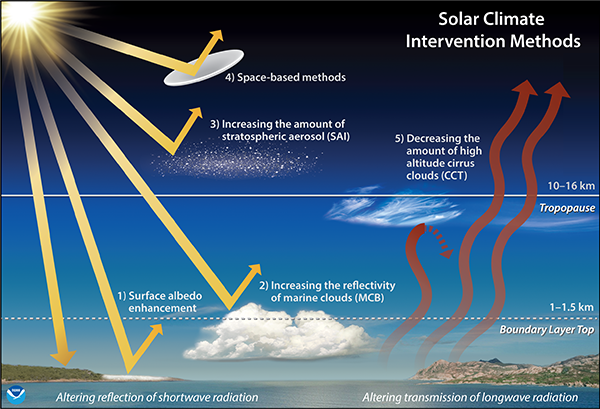2025 News & Events
Scientists turn to artificial intelligence to assess the warming effect of reduced pollution
13 January 2025
adapted from the story by NOAA Communications

A global reduction in sulfur pollution from shipping that has inadvertently contributed to recent warming of the Earth is providing insights into the challenge of evaluating one of two major proposed solar climate intervention approaches, marine cloud brightening.
In 2020, the International Maritime Organization imposed a sharp reduction in the level of sulfur in ship fuel to reduce emissions of sulfate aerosols and sulfur dioxide – pollutants associated with premature deaths from asthma, lung cancer, cardiovascular and pulmonary diseases, to improve air quality in coastal and large port communities.
By decreasing sulfur pollution, the cleaner fuels also reduced the reflectivity of low-level marine clouds that aerosol particles in the exhaust had previously brightened – reducing the cooling effect of clouds that shaded the ocean from the sun's rays.
Soon, observers noticed a decrease in 'ship tracks,' those distinct, bright white, linear clouds that form in the trail of large ships, allowing more sunlight to heat the ocean surface. But quantifying the warming effect of increased sunshine on the ocean surface using conventional climate models has proven challenging because they simply can't represent clouds well enough.
"Clouds are one of the most ephemeral natural phenomena, changing all the time as they drift through the sky," said Graham Feingold, the Clouds, Aerosol, & Climate research program lead at NOAA CSL and coauthor of the current study. "How do you design an experiment to understand their impact on the temperature of Earth's surface below?"
Measuring the effect of missing clouds
NOAA scientists tried a new approach that harnessed the powerful pattern-recognition capabilities of artificial intelligence (AI) and machine learning to capture and reproduce the complex physical and chemical processes that control cloud formation and unmask the true climate impact that these ship-induced, sunlight-reflecting clouds once had.
In a new study published in the Nature Communications Earth & Environment journal, the researchers report a modest global warming effect attributable to the reduction in reflective ship track clouds over the heavily used shipping lanes in northeastern and southeastern Pacific and the southeastern Atlantic off the coast of Africa.

The estimate is in line with several recently published studies (G. Jordan and M. Henry, 2024; H.F. Geossling et al., 2024; M. Yoshioka et al., 2024; T. Yuan et al., 2024) that point to more widespread reductions in cloud reflectivity as a possible cause of record global mean temperatures in 2023. That research identifies the decline in low-altitude clouds in the northern mid-latitudes and the tropics, particularly over the Atlantic ocean, where the most unusual temperature records were observed in 2023.
The current study is specific to the contribution of the shipping industry to reductions in stratocumulus cloud brightness.
"Just how much the IMO2020 regulations contribute to this warming compared to other factors, such as reductions in particulate matter from other sources, or global-warming induced reductions in low clouds, remains uncertain" said Jianhao Zhang, lead author of the study. Zhang is a research scientist with CIRES at the NOAA CSL.
A tool to help scientists find a signal in noise
What's important about this research, Zhang and his co-authors say, is the success of AI at teasing out a robust signal from very noisy and highly variable climate data.
Ship tracks are the product of sulfate aerosols interacting with low-level marine clouds. These aerosols act as efficient cloud 'seeds' (or cloud condensation nuclei), ramping up the available sites on which cloud droplets can form and increasing the reflectivity of the clouds along the ship's path. This is the same mechanism underlying the concept of marine cloud brightening – a climate intervention approach that proposes to increase the reflectivity of marine clouds by spraying sea salt aerosols into the atmosphere instead of sulfate particles. For this reason, ship tracks are studied as a direct analog to MCB.
To estimate the cooling effect that these ship tracks used to have, an ensemble of neural networks was trained with multiple years of global cloud observations from satellites collected before 2020 over three major shipping corridors in the Pacific and Atlantic oceans where ship tracks are the most prevalent. The neural networks were then tasked with simulating the observation record beyond 2020 as if the IMO2020 regulation had never taken place, generating a 'business as usual' scenario.
Comparing the AI-generated 'business as usual' dataset with the real post-2020 cloud observations effectively erased the noisy background of natural variability from the data, revealing the signal of the change, Zhang said.

The most critical part of this analysis is the many years-long data records of cloud properties used for the training and comparison datasets, collected both before and after 2020 by the MODIS (Moderate Resolution Imaging Spectroradiometer) and CERES (Clouds and Earth's Radiant Energy System) instruments, both aboard NASA's Terra and Aqua satellites. Without this long data record, AI would not have been able to differentiate between the ship-induced clouds and natural cloud variability.
In short, said Zhang, changes in cloud reflectivity whether intentional or due to climate change will be difficult to detect above natural variability, a finding that has direct implications for evaluating the potential of marine cloud brightening.
NOAA is currently conducting advanced modeling, laboratory and observational studies of the stratosphere and marine boundary layer to help fill important gaps in science's understanding of the climate system, including research in how to effectively evaluate solar geoengineering techniques, including marine cloud brightening. NOAA is not field-testing or deploying solar radiation modification methods or techniques.
"Any outdoor test of marine cloud brightening is going to face a real challenge of detectability," Feingold added. "This may require a much more ambitious test, in terms of size or timescale, than has generally been considered in order to demonstrate whether or not it's viable."
Zhang, J., Y.-S. Chen, E. Gryspeerdt, T. Yamaguchi, and G. Feingold, Radiative forcing from the 2020 shipping fuel regulation is large but hard to detect, Communications Earth & Environment, doi:10.1038/s43247-024-01911-9, 2025.
Abstract
Reduction in aerosol cooling unmasks greenhouse gas warming, exacerbating the rate of future warming. The strict sulfur regulation on shipping fuel implemented in 2020 (IMO2020) presents an opportunity to assess the potential impacts of such emission regulations and the detectability of deliberate aerosol perturbations for climate intervention. Here we employ machine learning to capture cloud natural variability and estimate a radiative forcing of +0.074 ±0.005 W m−2 related to IMO2020 associated with changes in shortwave cloud radiative effect over three low-cloud regions where shipping routes prevail. We find low detectability of the cloud radiative effect of this event, attributed to strong natural variability in cloud albedo and cloud cover. Regionally, detectability is higher for the southeastern Atlantic stratocumulus deck. These results raise concerns that future reductions in aerosol emissions will accelerate warming and that proposed deliberate aerosol perturbations such as marine cloud brightening will need to be substantial in order to overcome the low detectability.